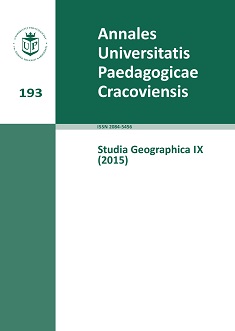Spatial, social and organizational aspects of accessible tourism
Keywords:
accessibility, disability, health impact, social impact, tourism, universal designAbstract
Tourism has many dimensions. Travelling provides a huge opportunity for people with disabilities. Disabled people often feel the most comfortable in their place of residence, place of work, natural environment associated with their routine. This is due the fact that said environment has already been accessed and personalized to their special needs. The farther from their natural environment, the more barriers a disabled person faces. Tourism has a spatial character, therefore it is related to movement. People with disabilities have the same motivation for travelling as healthy people, however, their full participation is often limited by numerous architectural, organizational, or even mental barriers, connected with their own concerns. Meanwhile, the number of people with disabilities is growing. Disturbing is also the increasing number of people temporarily disabled after strokes or hearth attacks. Tourism by movement allows to eliminate the unpleasant consequences of disability in both physical and mental terms. The purpose of this article is to present the spatial aspect of tourism of people with disabilities, the barriers that they face while travelling and leaving their customized environment. Additionally, the paper presents the role of tourism in the process of social rehabilitation of the disabled and their activation with the rest of society.References
Barczyński, M. (1993). (ed.). Medyczny Słownik Encyklopedyczny. Kraków: Oficyna Wydawnicza „Fogra”.
Darcy, S. (1998). Anxiety to Access: Tourism Patterns and Experiences of New South Wales People with a Physical Disability. Sydney: Tourism New South Wales.
Darcy, S. (2010). Inherent complexity: Disability, accessible tourism and accommodation information preferences. Tourism Management, 31(6), 816-826.
Darcy, S., Daruwalla, P.S. (1999). The trouble with Travel: People with disabilities and Tourism. Social Alternatives, 18(1), 41-46.
Dłużewska, A. (2011). (ed.). Nowe wyzwania edukacji turystycznej. Turystyka w obszarach odmiennych kulturowo i przyrodniczo cennych. Turystyka osób niepełnosprawnych. Warszawa: Wydział Turystyki i Rekreacji, Szkoła Wyższa Przymierza Rodzin.
Donnelly, J. (2003). Universal Human Rights in Theory and Practice. New York: Cornell University Press.
European Commission. (2012). Access – City Award 2012: Rewarding and inspiring accessible cities across the EU. Luxemburg: Publications Office of the European Union.
European Commission. (2014). Commision Staff Working Document. Report on the implementation of the UN Convention on the Rights of Persons with Disabilities (CRPD) by the European Union. Brussels: Publications Office of the European Union. Retrieved from http://ec.europa.eu/justice/discrimination/files/swd_2014_182_en.pdf
Grabowski, J. (2008). Projekty na rzecz rozwoju turystyki osób niepełnosprawnych. In: A. Stasiak (ed.), Rola krajoznawstwa i turystyki w życiu osób niepełnosprawnych. Warszawa: Wydawnictwo PTTK „Kraj”.
Grammenos, S. (2013). European comparative data on Europe 2020 & People with Disabilities. New York: Cornell University. Retrieved from http://digitalcommons.ilr.cornell.edu/cgi/viewcontent.cgi?article=1569&context=gladnetcollect
Halemba, P., Hermaciński, R. (2009). Sport i turystyka osób niepełnosprawnych. Kielce: Wyższa Szkoła Umiejętności im. Stanisława Staszica.
Hjalager, A-M. (2010). A review of innovation research in tourism. Tourism Management, 31,
–12.
Hunziker, W. (1951). Le Tourisme Social. Berne.
Intarapasan, B. (2009). Cultural Heritage across Borders: Inclusive Tourism And Barrier-Free Design In The Greater Mekong Sub-Region, A Thesis Submitted in Partial Fulfillment of the Requirements for the Degree Doctor of Philosophy. Bangkok: Silpakorn University.
Kaganek, K. (2007). Kreowanie produktów turystycznych dostosowanych do potrzeb niepełnosprawnych. In: A. Borowicka, A. Borowicka, W. Heliński (eds.), Tworzenie i dostosowywanie produktów turystycznych do potrzeb osób niepełnosprawnych. Szczecin: Forum Turystyki Regionów, 9–18.
Łobożewicz, T. (1991). (ed). Turystyka ludzi niepełnosprawnych. Warszawa: COIT. Mace, R., Hardie, G., Place, J. (1991). Toward Universal Design. In: W. Preiser, J. Vischer, E. White (eds.), Design Intervention. Toward a More Humane Architecture. New York: Van Nostrand Reinold, 155–175.
Porter, M. E. (2006). Przewaga konkurencyjna: osiąganie i utrzymywanie lepszych wyników. Gliwice: Helion.
Preisler, M. (2011). Turystyka osób niepełnosprawnych. Studia Periegetica. Zeszyty Naukowe Wielkopolskiej Wyższej Szkoły Turystyki i Zarządzania w Poznaniu, 6, 27–36.
Propopiuk, M. (2005). Udział osób niepełnosprawnych zamieszkałych na terenie Południowego Podlasia w turystyce aktywnej. In: F. Midura, J. Żbikowski (eds.), Krajoznawstwo i turystyka osób niepełnosprawnych. Biała Podlaska: Państwowa Wyższa Szkoła Zawodowa im. Papieża Jana Pawła II w Białej Podlaskiej, 143–150.
Przecławski, K. (1979). Socjologiczne problemy turystyki. Turystyka i wychowanie. Warszawa: IW CRZZ.
Tourism Center, University of Minnesota. (2015, January 10). Design and travel with Disabilities. Retrieved from http://www.tourism.umn.edu/about/news/design.html.
Wołowiec, S. (2001) Bariery w turystyce dzieci i młodzieży niepełnosprawnej z Podkarpacia. Medycyna Rodzinna, 3, 68–73.
World Health Organization. (2011). World Report on Disability 2011. Retrieved from http://whqlibdoc.who.int/publications/2011/9789240685215_eng.pdf?ua=1.
Downloads
Published
Issue
Section
License
The submission of a paper to be published is synonymous with an agreement to transfer the copyright free of charge from the author to the publisher. The author also agrees to permit the publisher to publish the paper in printed form, open access online form, digital library form and other digital platforms with which the publisher has or will have a publishing agreement. Furthermore, the author agrees to not limit the number of copies that may be printed or issued by the publisher. In the case of co-authored papers, it is assumed that the corresponding author is authorized to represent the remaining co-authors in this respect. Authors are requested to sign a copyright declaration.

